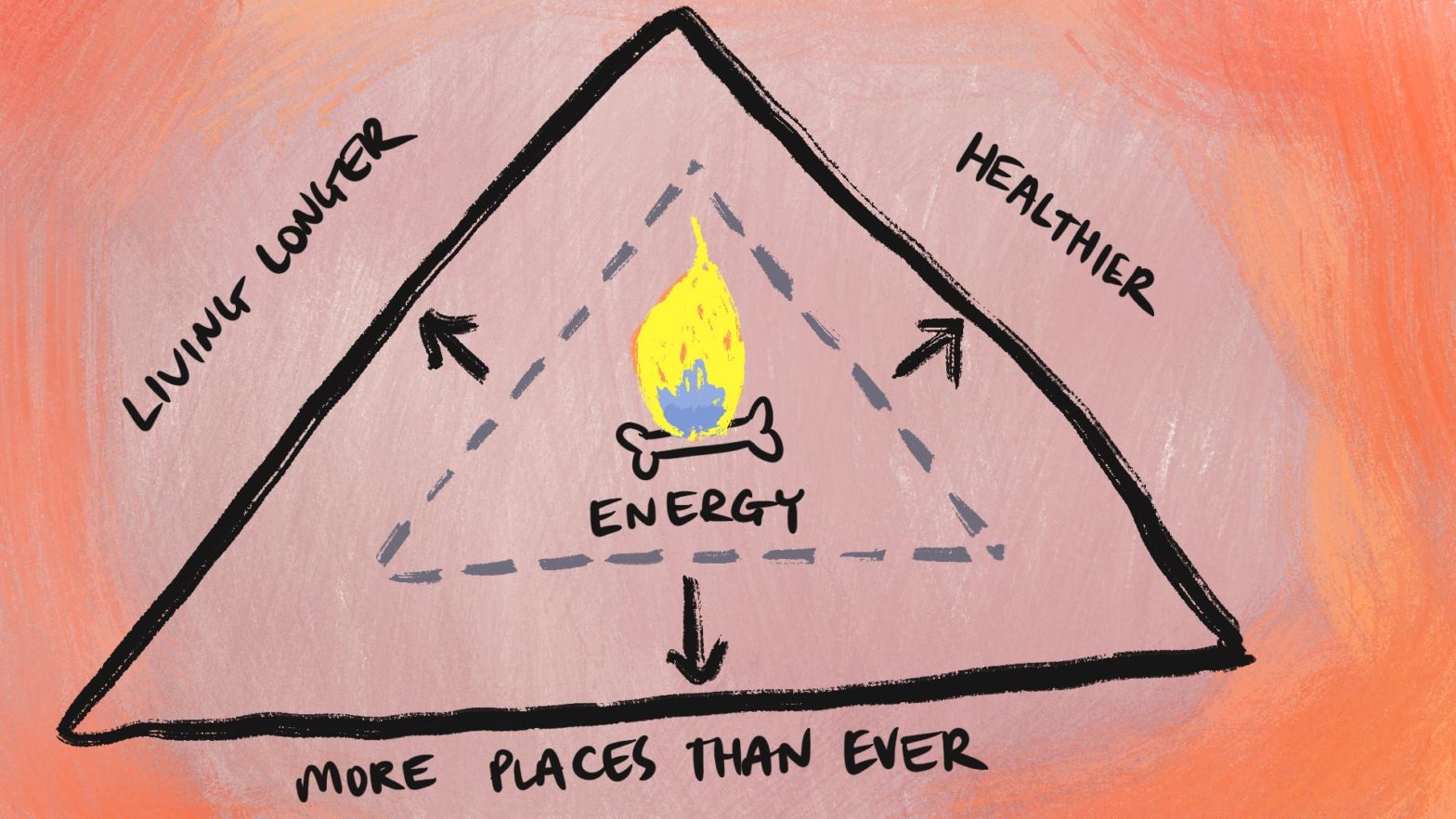This is a loose transcript of a talk given at 99Designs in Melbourne Australia on Thu 3 November. Throughout history, designers have helped humanity break limits. We’re living longer and in more places across the planet than ever before, and with bodies that are decidedly super-human compared to our ancestors. But what happens when the world we thought was limitless starts to push back? When the systems we thought we controlled and dominated begin to show us that we aren’t ruler of all, but dependant on all? Can the very process of Design – the one that got us here – get us out of it?
When I decided to study Design, I thought what I was doing was finding a way to ‘express my creativity’ – a way to use my heightened visual sensitivity to make the world a more beautiful place. But now, 20 years later, I find myself as a founder of a company whose intention is to make the planet a more habitable place for humans once I’m gone. That’s not where I thought Design could end up.

This morning, I spent 3 hours discussing cow shit. Understanding how it works, why it’s bad (and good), and how we might help the world understand it better, too. There were a lot of technical words but, in the end, we’re talking about shit.
In my view, helping to restore the natural environment so that we’ve got some chance of eeking out a higher quality human existence for longer than if we didn’t is one of the world’s most pressing problems. And, if I can find myself – a designer – in that conversation, I believe other designers can and should be there, too. So that’s what I’m here to talk about. How I think I did it and how others might do it also.
A note about privilege
Before I get started, I want to call out that I’m aware that this point of view comes from a place of privilege. I’m tall, white, male, heterosexual, have English as my native language, I was lucked into a non-abusive, very loving family – the deck is stacked in my favour. Not everyone has it this easy so, maybe it’s not possible that we can all do what I did. But, I think it’s still worth sharing this in the hope that you’ll find your own nuggets of wisdom here, and re-mix these ideas so that they work for you. This isn’t about me ‘telling you what to do’. It’s about me sharing a story so that you can process it and work out the bits you agree with, disagree with, or, like how most diversity works, just make it better.
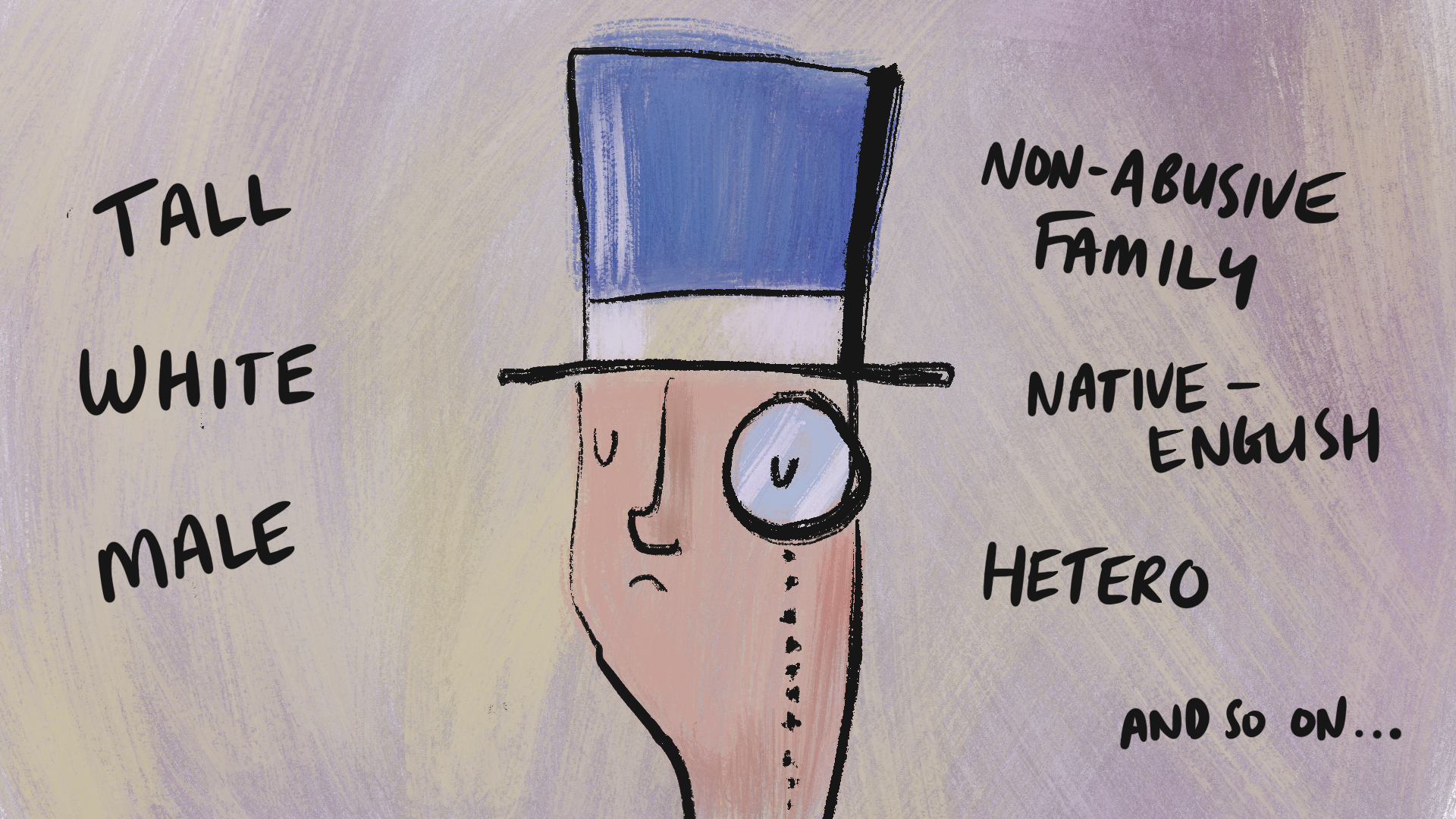
A bit about where we’re at and why it’s urgent now
Throughout history, the process of Design has been used for much more than ‘making the final thing look nice.’ Even as far back as something like 1974, I can’t remember the exact year but it’s in Victor Papanek’s book, Design for The Real World, people have been thinking about what Design is for, and what it does.
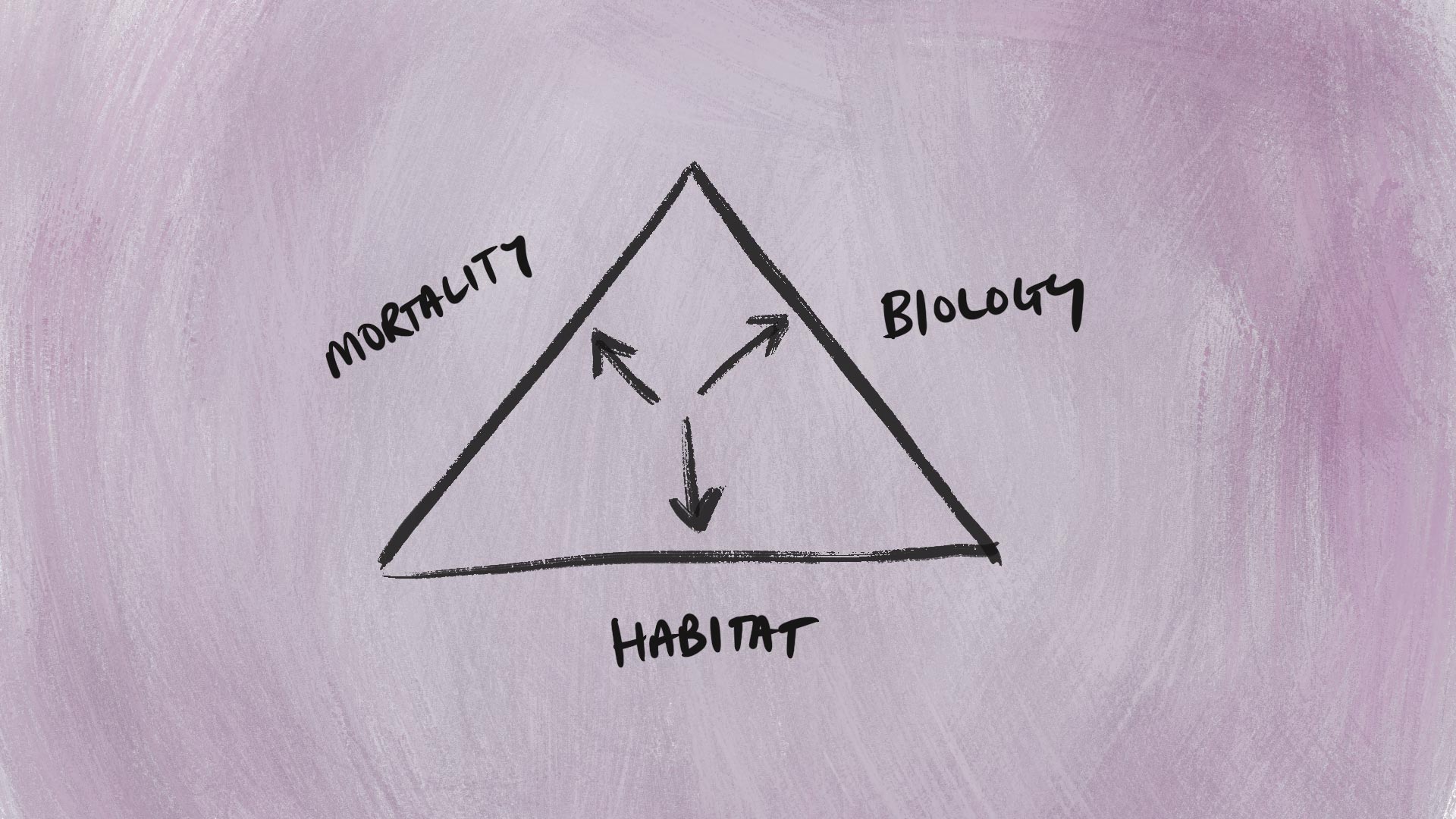
At the risk of using a very broad brush, Design has been used for pushing boundaries and helping humans overcome limits; those limits that come inherent with the body in which we live.
Design is helping us live longer lives in bodies that are, by any measure, super human, compared to our ancestors. We’ve also colonised environments where, without Design, human bodies cannot live – whether that’s icy cold places or roasting hot places (ski slopes in desert for goodness sakes!). And, because we’re running out of room to put people comfortably here on Earth, design is also helping us look beyond the planet. I have some strong opinions about that expansion but that’s a whole other talk.
So, whilst the methods of Design have helped with all of this ‘expansion’ of human limits, we’ve required one core thing to underpin all of it. That thing is energy.
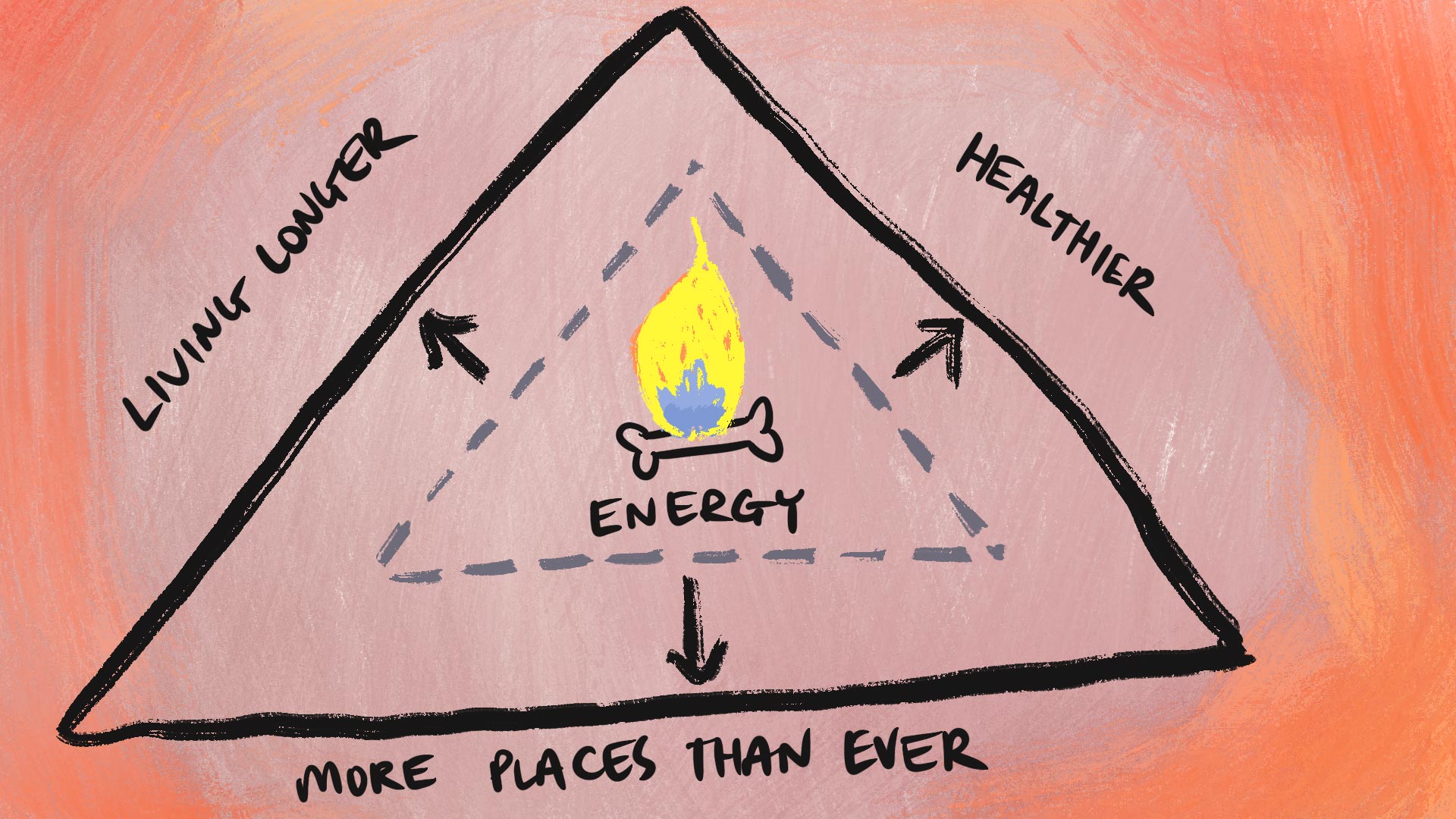
For many years, we’ve been burning the bones we found in the ground to fuel our expansion. We’ve burned bones to extend our lives, our health, and our habitat to live relatively energy-rich lifestyles. Of course, that richness isn’t equally distributed around the globe (and therein lies one of our fundamental problems) but more on that later.
The thing is, we’re running out of bones and we’ve learned that the whole bone-burning thing has had some side effects. Let’s simplify those side effects and call it ‘climate change’. It’s great that we’ve realised this effect, and it’s great we’re doing something about it. We’ve realised that bones are finite and that, in comparison, sun and wind and other ‘renewable’ energy sources are essentially limitless. So, we’re pivoting. And, if we’ve got an infinite energy source, we can continue to break those limits and keep expanding now, right? With a source like the sun, we’re saved.
But not so fast.
See, I thought this too. But then I read a book called An Inconvenient Apocalypse, and it changed a few things in my brain. Whilst the energy sources might seem infinite, humans are actually in the business of energy conversion and that’s where, like bones, we’re going to hit limits. We can’t use the sun without something in between (unless we’re tanning) and we can’t use wind unless we’re happy with it blowing us to places that we don’t necessarily want to go.
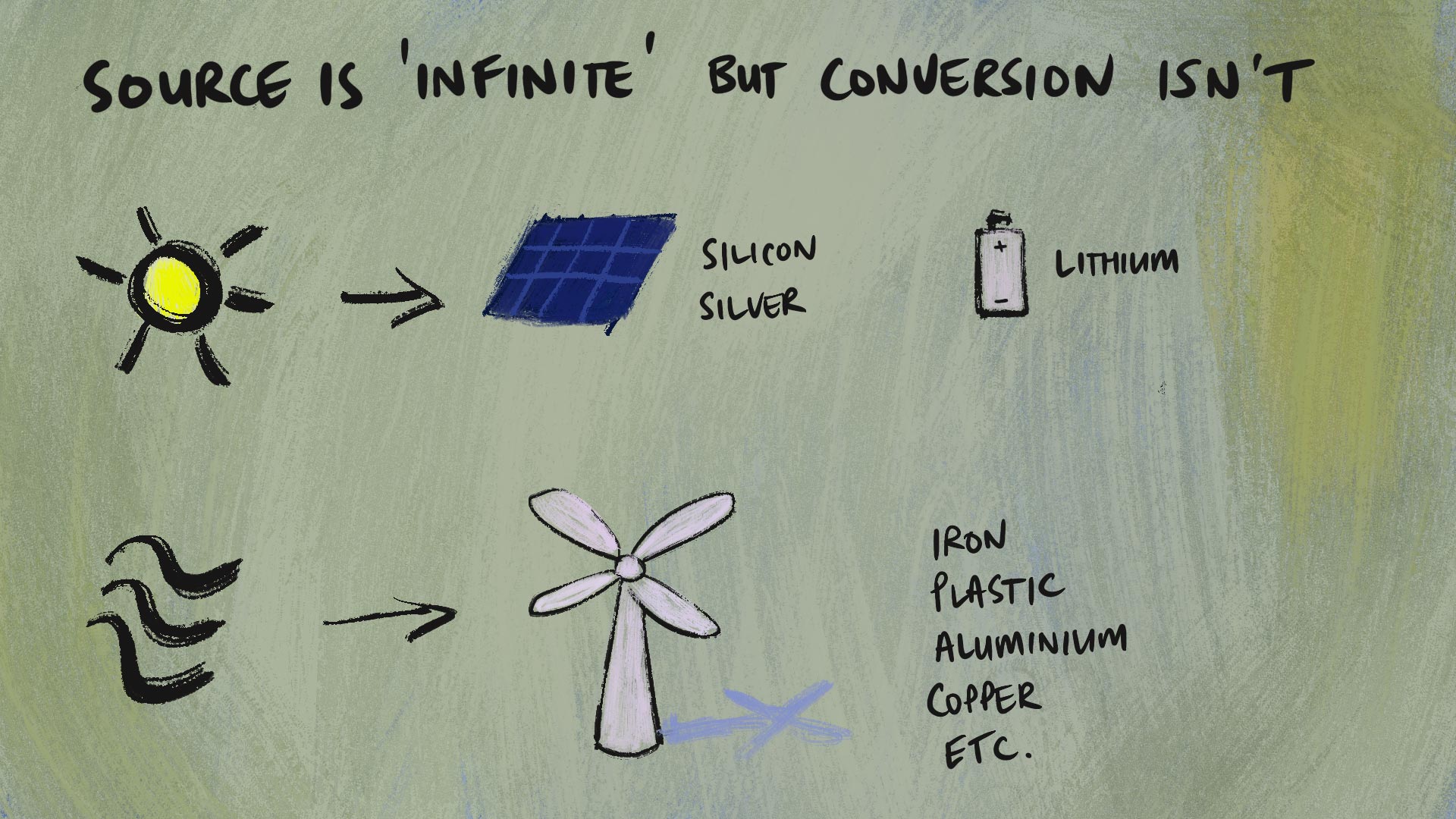
To convert solar energy we’re currently using solar panels. To store that energy captured by solar panels we’re using batteries. We need both things – to capture it and to store it.
But, to make a solar panel (or the number of solar panels we need to continue on our current expansion trajectory) we need raw materials – Silicon and Silver are the primary raw elements used to make the panels, and loads of lithium to store the energy in batteries.
To convert wind energy into something we can use, we also need raw materials. A single wind turbine is currently manufactured using a combination of iron, plastic, aluminium, copper and a bunch of other things. The manufacturing process itself needs energy, too (like, where plastic comes from) and so we start to see a vicious cycle emerging.
Now, unless I don’t understand what Mr Zanzyk taught me about physics and chemistry in high school, there are only so many raw materials in the world (118 in the periodic table as of 2022). We’ve used a chunk of them already for, what is largely kind of useless stuff. In fact, I read something the other day that said we’re about the enter the age of ‘above-ground mining’ because there are more raw materials sitting in landfill now that there is underground. You could say that this is all rather wasteful. That physical stuff is problematic and if we just stopped buying consumer goods or making things, maybe digitised a bunch of stuff in the metaverse, we’ll be better off. Right?
But, technology won’t save us either because digital runs on raw materials, too.

A simple example of a current, global phenomenom comes from the very field we’re practising within – digital technology. We (about 5 billion of us) are currently producing infinite amounts of video. Video, as far as data goes, is expensive. Exponentially more storage space is required to store this video than say text or sound or static images.
Where is all this video being stored? Well, data centres of course. Data centres full of servers. How are servers made? Well, they’re manufactured. From what? You guessed it, raw materials. Here we are again. Back to raw materials. In fact, a single server uses a combination of 50 of 90 of the world’s raw materials. Why do we need all this video in the first place? Well, social media companies have worked out that the more data they collect of our lives, the higher resolution picture they’ll get of us about who we are and what we like. This means they can sell higher value ad space to brands who want to ‘connect’ with us so that people who make junk can get better at convincing us we need it. This cycle just uses up the very raw materials we’re going to need to extend life on Earth even quicker. It’s a toxic cycle. It’s f**king terrifying.
I’ll just pause a bit to let that sink in.
Why are designers stuck on surface level problems?
So, things look a bit shit. Maybe they feel a bit hopeless. But, the thing about human existence is that it’s a complex-adaptive system (see Dave Snowden’s work on this re: types of problems that exist in the world). That means that things aren’t causal, but, rather, they are dispositional. Our actions aren’t part of an equation where if I do X, Y will definitely happen (we see this in Design all the time). It’s more that if I do X, under these conditions, Y is more pre-disposed to happen (but not guaranteed). And so, in my mind, this is where hope lives – that what we’ve got isn’t a system written in stone. We can turn things around. And this is the space in which designers can contribute.
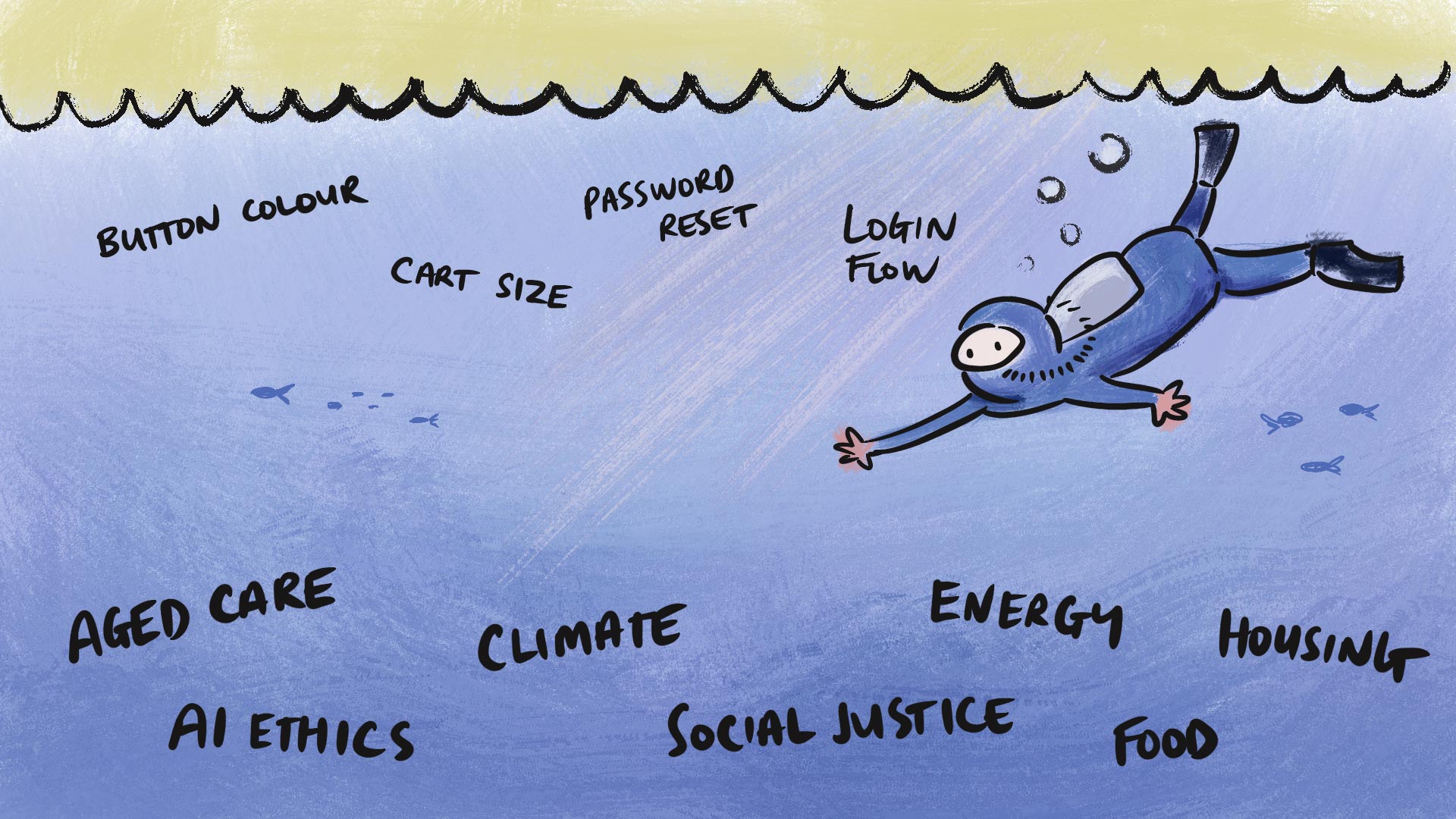
The problem is, when I began my design career, I didn’t know what Design was. I thought my job was to create optimised buttons, cart checkout experiences, login flows and password resets to make profitable companies more profitable. And I did that, for a while. And, it was fun, to see something you did turn into a number of a metric that made my boss happy. But, I’ve always had this burning urge that the way I was thinking could be used for more. And the world has some big f**king problems to solve – climate change, aged care, AI ethics, social justice, wealth inequality. They. Are. Huge. I just didn’t know how I could get there. It seemed so… deep.

But you know what, I had never seen (and still very rarely see) a Designer working on these problems, or talking about them if they are. Why is that? What is it about being a ‘designer’ that prevents us from working on bigger, gnarlier problems? Why aren’t we invited in to the conversation? And, does that mean what I’m doing now is just a glitch in the matrix? I’ve had a fortunate career on being able to work on this stuff and I hear loads of designers wanting to do the same but they’re having trouble ‘breaking in.’
“Hey, I’m the new designer”
Here’s how I’ve seen designers introduce themselves and talk about their craft:
A designer enters a new team, maybe meets their Product Manager counterpart first and they say, “Hi, I’m the new designer, let’s get to work.”

What happens in this moment is that the PM hears the word “Designer” and thinks about all the designers they’ve ever worked with. If the new designer gets lucky, that PM has worked with some designers who’ve done more than graphic design, but more often than not, it’s not the case. What happens is that PM is building a picture in their mind of what you do. They’re making calls and setting up boundaries in their brain about when to get you involved in a conversation, and how to work with you. And that’s just the PM.

Now, if we escalate that introduction to others who you may encounter in your day-to-day collaborations, you may meet:
- A developer who has only ever worked with one other designer and that designer was a pixel-perfect control freak that didn’t know how to collaborate and made the engineer feel like shit. You don’t have a friend there, right off the bat. They are ‘anti-Design’.
- A client or boss who has a niece who’s ‘studying Design’ and they made some flyers or an invitation for their yacht club gathering last Saturday.
- A PM who, maybe in a previous life, worked with a designer who was a research-bias? Or a visual bias?
- Maybe another dev who worked with a few designers who knew nothing about HTML/CSS so they found it difficult to communicate and therefore you’re that person now.
Designers have a serious identity and branding problem
What we’re left with is a total mess. Every person you meet has a different idea of the role you play in helping the team make decisions, develop solution, test them, and iterate towards something that’s better for the world. What’s the default in this situation? They make a connection with the 1950’s version of commercial artist and you’re left putting lipstick on a pig, right at the end of the pipeline where it’s too late to have any strategic influence. I’ve written about this history in depth on my blog if you’re keen to go deeper.

After my first few roles like this, I got pissed off. Introducing myself a designer was not working, no one knew what I was or what I could do. So, I stopped introducing myself as a designer. What I replaced it with was talking about what I do, not what I am. In its simplest form, that’s all about Minimising Waste.

A designer’s skill set, at it’s most very basic, isn’t about solving problems, it’s about minimising waste.
No one likes waste. We don’t like to waste time, energy, or money (especially business). So, no matter whether you’re talking to an exec, PM, developer or someone else – waste is the common denominator. But, the problem with keeping it simple like that is that it’s also a bit abstract (just like being a ‘problem solver’… because, you know, PMs or Engineers etc don’t solve problems either, right? For what it’s worth, please don’t say to people you don’t know that you’re a problem solver.) And so, what I’ve learned is that it pays to be specific. Keeping things short may feel efficient, but they just leave more unsaid.

The word “Research” sounds expensive and evokes lab coats, and rigour, and lots of time. So, I changed it up: “I can help you gather evidence to make a more informed decision about what to do next.” Suddenly, that re-brands ‘expensive research’ into something that could mean a 5-minute check-in with a few folks in a coffee shop to make sure we’re not building something stupid. Or, a quick skim of analytics to see if we anyone is using things on desktop anymore.
Here’s another one: “I have the skills to invent and describe how people will interact with what we make.” Most people call this “UX” which leads an collaborator to ask “where’s the wireframe”. By using words like “interaction design” and explanations of it like the one above, it frees you to use whatever is in your toolbox to do your job. I haven’t created a digital wireframe in 10 years, but I’ve mostly spent my time in Interaction Design. It’s been pen, paper, workshops, whiteboards, doing just enough work to ensure the team knows what to build and why. It works.
And now let’s talk about the easy one – Visual Design or UI. People know what that is, right? Well, the problem we’ve got is that it’s more complicated than that. What we’re really doing is “Using colour, layout, typography to help us achieve functional goals or heighten an emotional response.” You could call it ‘Visual Design’ or “UI” but that doesn’t describe what is essentially Visual Engineering. I say visual engineering because any graphic/UI designer knows that it’s the relationships between the elements on the screen or page that matters. For what it’s worth, engineers get away with this all the time:
“Oh, well, if we make the CSS change, that’s going to break this other thing and there’s some refactoring time to do that so it turns out your ‘simple request’ is really expensive and we probably shouldn’t do it.” – Most developers I’ve worked with. PMs and Designers choose not to understand code and so, guess, what, developer wins.
But, it’s the same with Design. We get feedback that is solution-oriented, “Let’s change the button to purple and move on” but we know that when that button goes purple, it’s going to draw too much or little attention to this other thing on the page so we need to adjust the line-spacing or heading size to compensate. We need to ‘refactor’ the page but we never say that and people who don’t know the science behind how the eye works don’t think about it. Colours matter. Hierarchy matters. Visual relationships matter.
It’s our job to explain ourselves better.

“Creative” is a term that is so closely related to ‘magic’ or genius because for people who don’t have good lateral or divergent thinking skills, it seems that way. It also makes us feel good, to identify as ‘creative.’
But, I never call myself a ‘creative’ because I don’t do magic, I do Science. What I have are “strong lateral and divergent thinking skills”. I also have exceptional critical thinking skills, which is all about the ways I can take a large number of options and whittle them down to the best one suited to achieve the goals we’ve set out as a team to achieve. That’s what ‘creativity’ is, the ability to think laterally first, then apply constraints to critique those options to come out with the best one. It comes so naturally to us that we don’t even think to explain the process to others. Trust me, most people are really shit at it, too.
Show your workings. Explain your thinking.
As designers, we don’t like showing shit work. I mean, maybe no one does? We often begin designing something and only through designing do we evolve the idea to think of other pathways of exploration. We do this iteratively – expanding and critically thinking our way through the multitude of options to get to a ‘final design’ that we’re comfortable presenting.

But, I can’t count the number of times where I’ve presented a ‘final design’ only to have someone say, “Hmm, this is good. But what if we tried this? Or this? Or this?” Which often ends in a dumpster fire of design by committee.
What I want to say in those moments, but never did, was “I already thought about all that, you idiot, why don’t you trust me.” But, instead, now, I say, “I already thought about this…” and then I bring up my Figma file that has 500 artboards on it because I’ve ‘saved snapshots’ of my iterated thinking. I can say, “here it is, and here’s why it doesn’t work in the way you haven’t thought about yet because I’ve already done the thinking!”
Boom. Mic Drop.
The key takeaway? Keep your iterations and show them when you need to. It’s an incredible amount of work and skill that we hide from our co-workers for fear of looking a bit shit because we didn’t come up with the right solution the first time. Everything is iterative and your artefacts can help you have those conversations.
Developing your non-confrontational why
No matter how much time we spend, and no matter how much progress we make in climbing up the strategic ladder, there will always be times where we’re presented with a decision or direction that was set in a conversation we weren’t included in.

There are two ways to ask why that decision was made.
“Sorry, but why wasn’t I part of this conversation? I told you that I would prioritise being in that meeting and you left me out of it.”
Oof. Who’s going to respond positively to that? There’s accusation, attack, anger, and defensiveness all rolled in to one question. But there’s another way to do that and it’s grounded in a combination of vulnerability and curiosity.
“Oh, thanks for that. Sounds like it was a productive meeting. I reckon I could help there. Do you mind just sharing a bit more context behind the decision? It’ll be helpful for me in designing something that works.”
And with something like this, we’ve opened up an allyship. The Designer gets the background and context they need to go off and Design something that might actually end up revealing a problem that no one thought about in that original meeting.
Suddenly, when a presentation comes around, the Designer can present their deeper thinking, sometimes challenging those original assumptions, and then use the critical thinking of the team to make something better than what was ‘handed down from on high.’
This is a simple and contrived example but it’s really there to illustrate a point – there are two way to ask why. One way build friends and your reputation, the other creates enemies and further isolates the ‘designer’ to someone who’s a disgruntled team member. In all cases, it’s better to choose to be the former.
In my experience, finding your non-confrontational why (and also finding your non-confrontational “no, that’s objectively not a good idea”), starts to dismantle the ‘commercial artist’ stereo type of designer in co-workers minds. The next time an important strategic meeting happens, people like your Product Manager are more likely to request your presence in it, even if their boss doesn’t think it’s useful. That seat at the table we’ve been wanting is beginning to feel a little warm, right?
But, it’s important to note here that everyone is different and what feels natural to me will not feel natural to another. Designers need to work out what works for them, and for their team or the people that they’re trying to work with. It’s been 20 years of trial and error for me, and I’m still learning. It’ll probably be the same for you. Doing a course in conflict management, or even reading a book about it like Conflict without casualties will help.
The limits of your language will be the limits of your world
Designers seem to have the most power and influence when they are accepted and seen as a knowledgeable generalist. But, to be that knowledgeable generalist, we need to learn a few languages.

Learning the language of the science behind why we make decisions helps us provide reasons for our work. If we have reasons for our work it’s far easier to have a non-confrontational conversation about which solution or solutions meet the goals we’re trying to achieve. After all, it’s not designer versus the world that we want, it’s “here’s the science, do you really want to make a decision that goes the other way?”
Design is based in science, even though many of us enter it from the ‘arts’ angle. There is the science of psychology – unconscious bias and the limits of human capacity – are the materials we work with. For example, when we’re designing for ‘delight’, we can quote the peak-end rule to describe why one solution will work better than another. The Laws of Ux by Jon Yablonski is a great reference guide for you to begin building that vocabulary.
We need to be, of course, experts in ergonomics. A person can only hold a device in so many ways and thumbs and fingers can only stretch so far. Environmental factors like, “are they driving” influence this greatly. These limitations drive our choices about where and why we place buttons and key information as well as how people interact with the non-visual interfaces we create.
Business is the language of our employers and product managers. Building a language around economics and business is important so we can communicate with them and describe our designs in those terms. Increase revenue, reduce attrition, maximise retention – all those things are important to be able to demonstrate to our business-oriented colleagues that we understand where they’re coming from and that our seemingly simple design artefact has considered them throughout the process.
And, whilst we don’t need to know how to code (unless you really want to), knowing what our developers talk about when they say words like CDN, Azure, HTML/CSS, React front-end, performance, and so on only makes us more able to consider their constraints and push their boundaries where it’s appropriate to do so. The one thing I love about most developers I’ve worked with is that they love sharing what they know and often what they know or love makes for a better experience for the people we’re designing for – they just don’t know how to translate it to a ‘user experience’.
Finally, there is domain specificity. Whether you’re working in climate, housing, social justice, agriculture, health, education ,law or wherever you find your interests sparked, knowing the acronyms or the technical terms are critical. They are critical to building strong relationships with domain experts (I spend a lot of time listening to how smart professors profess to be), but also to ensure that those technical terms don’t leak through an interface and confuse the hell out of users. I had a conversation earlier where, in our meeting, we use the words “enteric fermentation”. Another way to say that is cow burps and farts. Which one feels easier to understand given everyone here isn’t an environmental scientist?
So, here we are, ‘designers’ for whom most of our work is actually translation. The bigger our vocabulary across not only our own specialisation of design, human factors, psyschology and so on, but also everyone else’s, the more able we are to do our jobs – make things that don’t harm people and improve their lives instead. We also begin to sound way more intelligent than ‘the person who makes things look nice’ and it’s those ‘smart people’ who, again, find themselves in meetings that decide how the world will run.
Write my thoughts down (or at least what I think is true today)
This was and continues to be the most transformative part of my practice and it’s both one of the easiest and most difficult things to do – write down what you think is true today.

Writing is linear in nature. That means that, to write well, you have to order your thoughts. But, it works a bit like design. As soon as you start writing, you have more thoughts, and those thoughts generate even more thoughts. This is writing’s strength because it forces you to sort it out. To separate those intertwined threads and make them clearer ideas.
Keeping a blog going for over 15 years has and continues to be the most transformative act in making be a better designer.
Writing also helps improve your vocabulary and, over the years, it creates a snapshot of your ever evolving knowledge. I look back at some of the things I wrote over 10 years ago and think, “Gee, you were an idiot.” But then there are other thoughts I re-read and think, “Woah, that’s really insightful.” Writing begets more writing, which begets clearer thinking, which makes you a stronger thinker and presenter.
This talk tonight is a combination of 4 different recent blog articles and I can only spin up a talk like this because I’ve already done the writing to clarify what I think to be true right now through… you guessed it, writing down.
So, start a journal. Start a blog. Start a collection of index cards or post-it notes. No matter how much I know that privilege can change things, I know one thing – writing will supercharge things for you.
Know thyself
So far, I’ve talked a lot about influencing externally. How we can have better conversations with others to get that elusive ‘seat at the table’ if we want it? But, one of the most important things to understand, if we want our work to be sustainable, interesting, and exciting to us is to get to know ourselves and begin to be comfortable with the strengths we each have. Once we know those things we can find the environment that suits us and in which we thrive.

Benson talked earlier about Design Ops and Design Systems. You DO NOT want me in charge of that. I’m terrible at consistency (when things stay the same for too long, I need to shake things up). He also mentioned reducing the amount of context-switching for designers – creating space for deep work. And, whilst I agree that I need space for deep work sometimes, I actually find that having 4 things on the go at once is better for my problem-solving capabilities and my general energy levels than having just one problem to solve for weeks. It’s why I avoid large enterprises like the plague where work can take months to ship and prefer start-up work, often 4 or 5 different ones at time. Iterate fast, frequently, and learn.
None of these things are morally good or bad on their own. I used to but no longer envy people who have different skills than me. Now, I just know the world needs that diversity. We need the Megans and the Bensons of the world to do the work they’re doing in these large orgs. There is genuine social impact there because they’re working at huge scale. Come up with a new interaction pattern and ship it to a few million people around the globe, you will change how the internet (and society) evolves. The world also needs folks like me because I do talks like this from my years of experience in changing jobs and roles every 3 months or so because what I love is working in science, immigration detention, electric vehicles, VR, education, health, human services, and now climate.
I have this saying – it’s difficult to grow a mango tree in Melbourne. You can do it, but you’ve got to put loads of support around it; plastic covers in Winter so it doesn’t die of frost, and then you have to water it relentlessly in Summer when it’s dry and Melbourne gets no rain. But, no matter how much you care for it, the mangoes grown down here are never sweet and juicy like the ones grown in Mareeba, Queensland. It’s just not a plant that’s suited to this climate. It doesn’t belong. And we’re OK with that. Well, most of us are.
Designers are just plants with complicated emotions. For some reason, we believe that we should ‘adapt to anything’. Having trouble at a large enterprise, just work harder, or build better relationships, or blah blah blah. Put that plastic sheet over yourself in winter, drink more water in summer. But you still won’t be a juicy mango.
The alternative is to work out what type of plant you are – enterprise/startup, research/visual, code/strategy etc, who you need around you to compliment you, and then go looking for an environment in which you will simply thrive because you’ve been planted in the right spot.
For example, my co-founder and I are brilliant compliments to each other. She has a background as an engineer and is detail-oriented, thorough, loves a good spreadsheet. She did budgeting for our business when she had covid because, for her, that was the ‘easy thing to do’. But, set her a task to connect with randoms on LinkedIn to grow the network, or pull together and execute a content campaign to grow our presence in the market and she quivers with fear like I do when I see a spreadsheet with a million cells. But I love doing the networking stuff. It’s easy, energising and fun. So, we’re doing this work together, and the business (and our families) are better off for it.
In the end, it’s about minimising waste
And so, I return to what designers do, not what we are. We are victims of our own identity and history. We keep messing around with titles – Web Designer, Multimedia Designer, UX Designer, Service Designer – all attempts to dig us out of a whole dug by our historical connection to commercial art in advertising.

But, from my experience, we are indeed some of the most valuable brains in society. We can think laterally and critically at the same time. We have innate curiosity and compassion which drives us to do this sort of work in the first place. We are, often, exceptional visual communicators. Let’s not waste it and the raw materials that make the world go round. There simply isn’t enough of it to waste.
Thanks.
